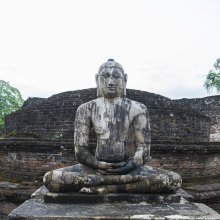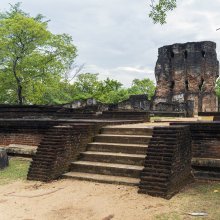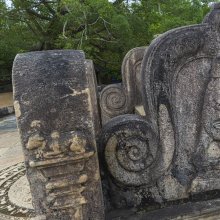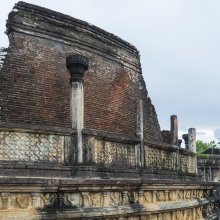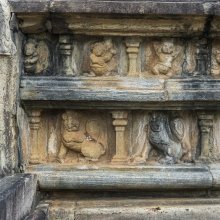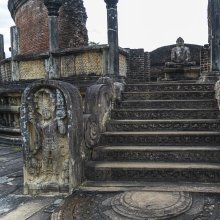Polonnaruwa, Polannaruwa, Polonnaruva: 2 definitions
Introduction:
Polonnaruwa means something in the history of ancient India. If you want to know the exact meaning, history, etymology or English translation of this term then check out the descriptions on this page. Add your comment or reference to a book if you want to contribute to this summary article.
Images (photo gallery)
(+18 more images available)
India history and geography
Source: archive.org: Ceylon Branch of the Royal Asiatic Society 1963Polonnaruwa (Polonnaruva) is the name of an ancient region in Ceylon (Sri Lanka).—The earliest lithic record of human habitation at Polonnaruva is a short cave inscription of the 1st century. The first allusion to the place in the Chronicles is a reference to the construction of the tank Topāvava in the reign of Upatissa I (365-406). But its antiquity goes back to much earlier times because there are good grounds for identifying Polonnaruva, or a place very close to it, with the fortress named Vijitanagara where a decisive battle was fought about B.C. 163 between the forces of Duṭṭhagāmaṇi Abhaya and the foreign ruler Elāra.
The first king to found a Monastery at Polonnaruva was Aggabodhi III (628) who built the Mahāpānadīpa-vihāra there. Aggabodhi IV (667-683) temporarily removed the seat of government from Anurādhapura to Polonnaruva and died at Polonnaruva. This was the first of several occasions on which the kings vacated Anurādhapura and went into temporary residence at Polonnaruva on account of invasion or civil war. Hence, it came to be called Kaṅdavura-nuvara or “the camp-city”.
Source: academia.edu: The Chronological History of Ancient Sri LankaThe Cholas occupied Polonnaruwa (Anuradhapura) in Sri Lanka in the 36th regnal year of Mahinda V. They took Mahinda V, his wife and all his treasures to Chola country. Mahinda died 12 years later around 200 BCE. According to Rajavaliya, Sena V attacked Tamils and routed them. A Chola king brought an army of 95000 Tamils and landed in Sri Lanka. Finally, Tamils took Mahinda V prisoner in his 36th regnal year. The Kalyani inscriptions and the Polonnaruwa inscription tell us that Siri Sanghabodhi Parakramabahu I was reigning in his 18th regnal year in the 1708th year of Buddha Varsha.

The history of India traces the identification of countries, villages, towns and other regions of India, as well as mythology, zoology, royal dynasties, rulers, tribes, local festivities and traditions and regional languages. Ancient India enjoyed religious freedom and encourages the path of Dharma, a concept common to Buddhism, Hinduism, and Jainism.
See also (Relevant definitions)
Full-text (+221): Kondivata, Kotthasara, Mahalagama, Andugama, Kalapilla, Mayurapasana, Madhukavanaganthi, Tinimakulla, Badaravalli, Sanniratittha, Damavihara, Pancaparivenamula, Pancavihara, Kandavura, Bhagirathi, Mangala-ganga, Campa, Venumati, Kandavuranuvara, Nilavahini.
Relevant text
Search found 11 books and stories containing Polonnaruwa, Polannaruwa, Polonnaruva; (plurals include: Polonnaruwas, Polannaruwas, Polonnaruvas). You can also click to the full overview containing English textual excerpts. Below are direct links for the most relevant articles:
A Short history of Lanka (by Humphry William Codrington)
Chapter IV - The Polonnaruwa Kings (1070 AD—1215 AD)
Chapter III - The medieval kingdom to the Chola conquest in the eleventh century (479 AD—1070AD)
Chapter V - The Dambadeniya and Gampola Kings (1215 AD—1411 AD)
Middle Chola Temples (by S. R. Balasubrahmanyam)
Temples in Polonnaruva < [Chapter II - Temples of Rajaraja I’s Time]
Temples in Mattottam (Rajarajapuram) < [Chapter II - Temples of Rajaraja I’s Time]
Vastu-shastra (5): Temple Architecture (by D. N. Shukla)
Temple architecture in Ceylon (Sri Lanka) < [Chapter 12 - History of Hindu Temples (Prāsādas and Vimānas)]
Temple architecture in Siam (Thailand) < [Chapter 12 - History of Hindu Temples (Prāsādas and Vimānas)]
Mahavamsa (by Wilhelm Geiger)
Early Chola Temples (by S. R. Balasubrahmanyam)
Temples in Punjai < [Chapter VI - Temples of Aditya II’s Time]
Vietnamese Buddhist Art (by Nguyen Ngoc Vinh)
2a. The Spread of Buddhism < [Chapter 1 - The evolution of Buddhist Art in South Vietnam and South East Asia]
